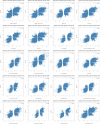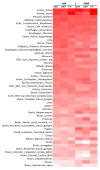Large-Scale Multi-Omics Studies Provide New Insights into Blood Pressure Regulation
- PMID: 35886906
- PMCID: PMC9323755
- DOI: 10.3390/ijms23147557
Large-Scale Multi-Omics Studies Provide New Insights into Blood Pressure Regulation
Abstract
Recent genome-wide association studies uncovered part of blood pressure's heritability. However, there is still a vast gap between genetics and biology that needs to be bridged. Here, we followed up blood pressure genome-wide summary statistics of over 750,000 individuals, leveraging comprehensive epigenomic and transcriptomic data from blood with a follow-up in cardiovascular tissues to prioritise likely causal genes and underlying blood pressure mechanisms. We first prioritised genes based on coding consequences, multilayer molecular associations, blood pressure-associated expression levels, and coregulation evidence. Next, we followed up the prioritised genes in multilayer studies of genomics, epigenomics, and transcriptomics, functional enrichment, and their potential suitability as drug targets. Our analyses yielded 1880 likely causal genes for blood pressure, tens of which are targets of the available licensed drugs. We identified 34 novel genes for blood pressure, supported by more than one source of biological evidence. Twenty-eight (82%) of these new genes were successfully replicated by transcriptome-wide association analyses in a large independent cohort (n = ~220,000). We also found a substantial mediating role for epigenetic regulation of the prioritised genes. Our results provide new insights into genetic regulation of blood pressure in terms of likely causal genes and involved biological pathways offering opportunities for future translation into clinical practice.
Keywords: blood pressure; epigenome; functional enrichment; gene expression; genome.
Conflict of interest statement
The authors declare no conflict of interest.
Figures










References
-
- WHO|A Global Brief on Hypertension. [(accessed on 25 June 2019)]. Available online: https://www.who.int/cardiovascular_diseases/publications/global_brief_hy...
-
- Wang X., Snieder H. Heritability and Familial Aggregation of Blood Pressure. In: Flynn J.T., Ingelfinger J.R., Redwine K.M., editors. Pediatric Hypertension. Springer International Publishing; Cham, Switzerland: 2018. pp. 159–176.
-
- Ehret G.B., Ferreira T., Chasman D.I., Jackson A.U., Schmidt E.M., Johnson T., Thorleifsson G., Luan J., Donnelly L.A., Kanoni S., et al. The Genetics of Blood Pressure Regulation and Its Target Organs from Association Studies in 342,415 Individuals. Nat. Genet. 2016;48:1171–1184. doi: 10.1038/ng.3667. - DOI - PMC - PubMed
-
- Hoffmann T.J., Ehret G.B., Nandakumar P., Ranatunga D., Schaefer C., Kwok P.-Y., Iribarren C., Chakravarti A., Risch N. Genome-Wide Association Analyses Using Electronic Health Records Identify New Loci Influencing Blood Pressure Variation. Nat. Genet. 2017;49:54–64. doi: 10.1038/ng.3715. - DOI - PMC - PubMed
MeSH terms
Grants and funding
LinkOut - more resources
Full Text Sources
Miscellaneous

